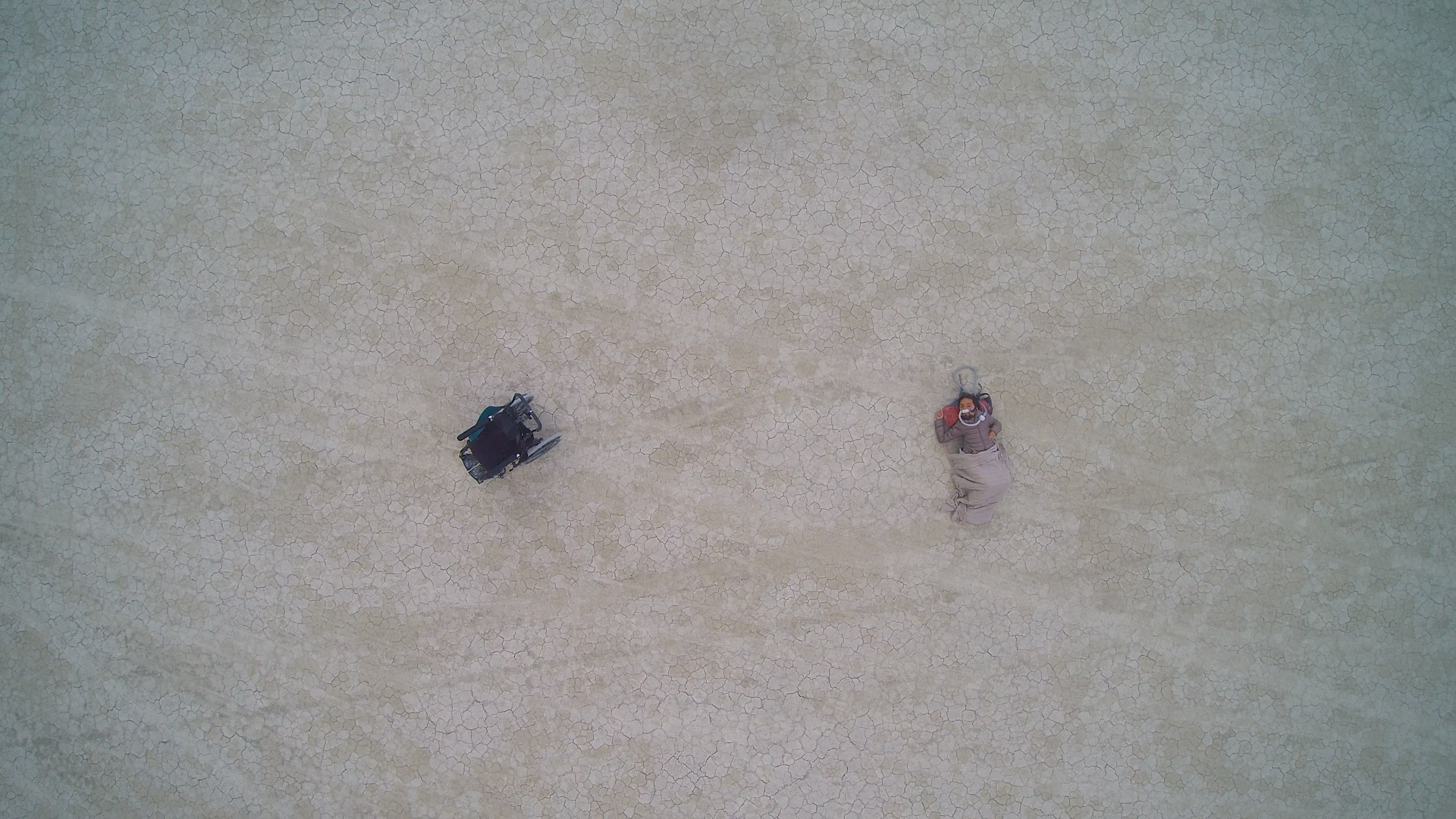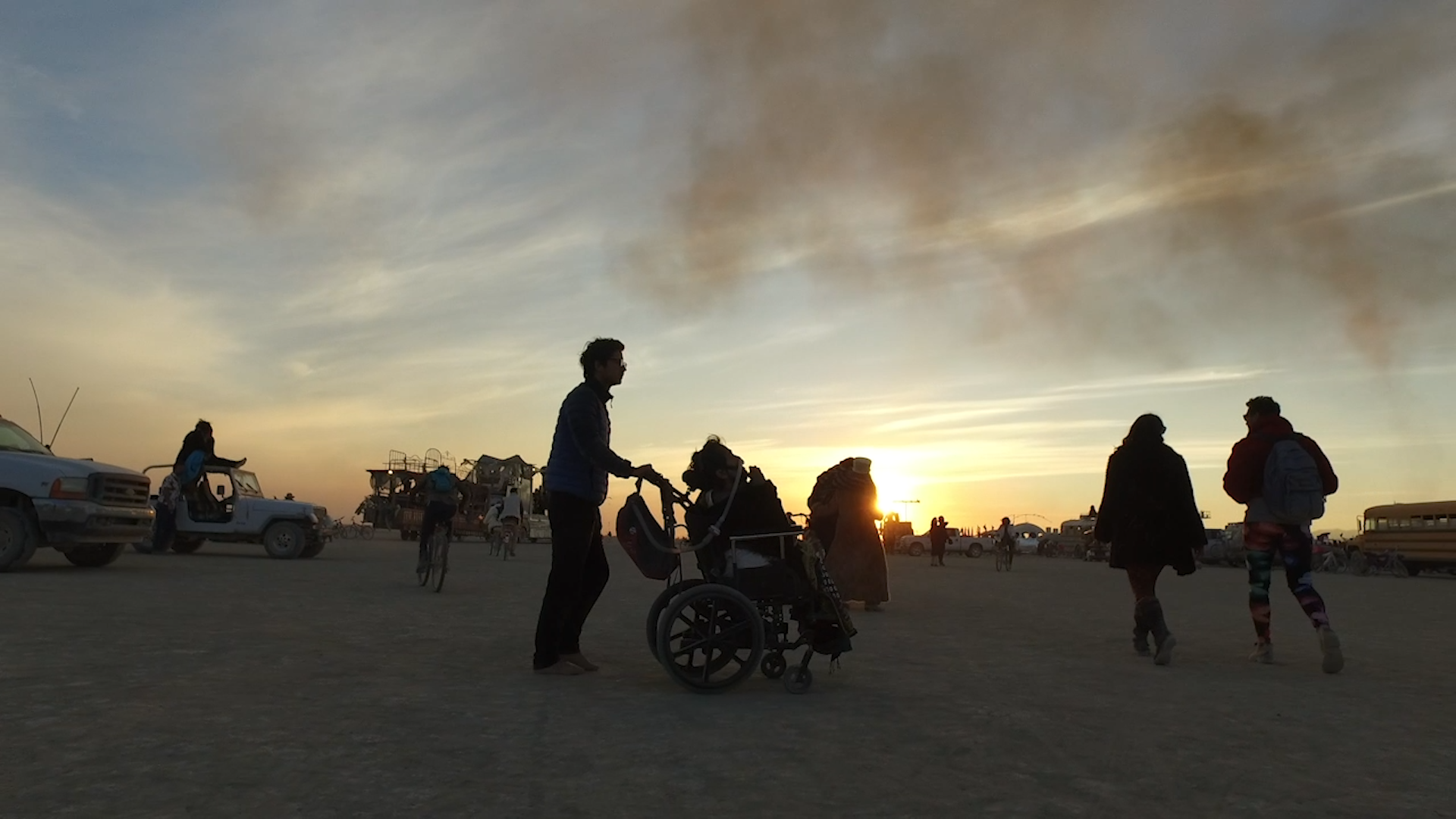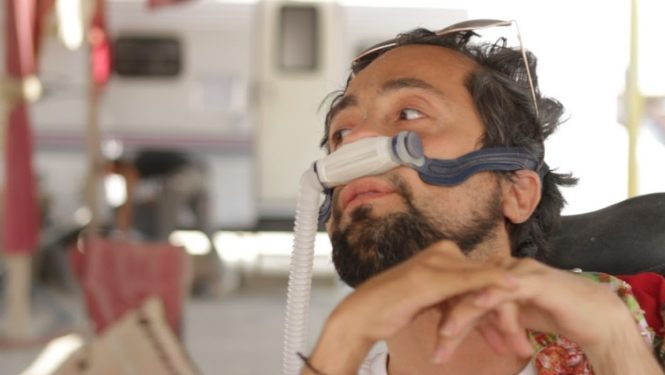In his documentary Unconfined (2022), Dr. Victor Santiago Pineda takes us on a journey to two of the world’s most transformative cities — Varanasi, India, and Black Rock City, Nevada. We spoke with the director and global disability justice leader about pilgrimage, social impact, and how Black Rock Citizens can co-create more inclusive and accessible cities.
Renowned human rights activist Dr. Victor Pineda spends his days teaching at UC Berkeley and running two global initiatives through his foundation: A World Enabled which partners with governments and companies to unlock Radical Inclusion; and Cities for All, which directly helps city leaders and communities create more inclusive, accessible, and resilient futures.
As a kid growing up in Venezuela during the 1980s, Pineda’s disability meant he was unable to go to school. His mother relocated her family to the United States, where Pineda earned a PhD with distinction in Urban Planning from UCLA and became the youngest delegate to participate in drafting the United Nations Convention on the Rights of Persons with Disabilities.
“That’s quite a big transition from being born into a world that wasn’t designed for me, to then ending up helping to design the world that I want to live in,” Pineda noted. “That’s a big kind of story arc to my life, and Burning Man was a very important piece and really accelerated that journey as well.”
We spoke with Pineda about the journey he took to two of the world’s most transformative cities — Varanasi, India, and Black Rock City, Nevada — and explored how his Burning Man experience impacted his work in the world.
Pineda and his team captured the pilgrimages, and Pineda’s subsequent experience during the COVID-19 pandemic, in the documentary Unconfined. “We wanted to bring the audience into a close, almost confessional set of video logs that then open up into a broader landscape of a hero’s journey and a discovery, not only in the outside world, but deeply an inner world, an inner set of discoveries,” he explained.
The short film Burners with Disabilities: Radical Inclusion on Fire brings us into Pineda’s Black Rock City journeys:
Tell me about yourself, your personal journey. Who are you and what do you do in the world?
I showed up to a world that was full of possibilities, but also full of barriers. Oftentimes the barriers seemed to be much more profound, much more intractable than the possibilities. That’s because I was born with a rare condition that made my muscles weak. I stopped walking by the time I was five, and was using a ventilator by the time I was in high school.
I have to navigate the world empowered by a really cool art car, which is my own custom-built wheelchair, and also this breathing machine that helps me take deep breaths. I was very much used for rolling around the world, having people look at me, and really making sure that I breathed good clean air. So I was kind of prepping my whole life for going to Burning Man, right? Rolling around… I always felt like I was an exhibit, right? And people just stared.
Unconfined shares your pilgrimages to Black Rock City and the holy city of Varanasi. Why was it important for you to take these journeys, and to document them?
Life has a way of unfolding in unexpected ways. I had been experiencing a lot of challenges with my marriage and my career. I worked really hard to create the life that I thought I wanted and it wasn’t working out that way. A friend of mine said, “Victor, you and I should get away. There are these cities in India that are the sacred cities, and the most sacred city of all is Varanasi. It’s a place that they called the sacred city of the dead. Perhaps we have to let go in order to find new openings and new doors.”
I had just got back from my first Burning Man in 2015. I discovered little bits of myself at that first Burning Man in every person that I encountered. And I was much more open to serendipity. I was much more open to being called on a journey. I was much more open to experiencing magic and seeking out magic in the default world, almost like Burning Man primed me to listen to my gut and my soul.
So when he threw that out there as an idea I was like, “Yep, that’s the right thing to do.” And what was phenomenal and really poetic was that Burning Man is about burning an effigy in order to bring something new to the world. And in Varanasi there’ve been pyres and cremation ceremonies for thousands of years on the riverbanks of the sacred river Ganges. To actually experience the smells, and the senses, and the colors and sounds of India, it was literally on the other side of the world, but a very elevated pilgrimage.
There were two different pilgrimages. The pilgrimage to Burning Man and the pilgrimage to Varanasi, and they both complemented each other very naturally. I didn’t write a script or set out to plan those two locations. They just appeared on my path and were able to really transform my understanding of the next chapter of my life and my place in the world.

Can you tell me more about that transformation?
The trajectory I found myself on — on the cusp of the first Burning Man experience was — I found myself not only overachieving, but overdoing and over exhausting myself in pursuit of some external validation… in pursuit of feeling like I belong in a world that wasn’t designed for me, in pursuit of feeling like my life would matter. Because so often, for many people with disabilities, we don’t feel like our lives matter or are worth living.
I wanted to change the narrative from being a human doing, to a human being. And that was the biggest transformation. All the PhDs and the presidential appointments and advising of the president of the World Bank and the UN work, negotiating human rights treaty, the foundation — all of those were just external pursuits to make sense of being a life worth living.
I needed Burning Man, needed those encounters and those warm hugs on the playa to feel whole again. And by doing that, then I can show up in the default world with a lot more courage and a lot more clarity and a lot more commitment to realize a world of potential.
Tell us about the scene in Building a City of Radical Inclusion and Unconfined when so many people were touching you. What was that like?
The scene in the movie was a dancing meditation. And one of the camps organized a beautiful sound healing concert and a good friend of mine said, “Victor, we’ve got to go to this place. I just have a feeling you’re going to love it.” We parked right in front of the camp, my friend, Luis, brought me out and carried me into the dancing meditation and the music was very soothing. And he just put me down on the floor in front of him. People just naturally gravitated toward a human body that was, you know, vulnerable, and organically started to help me move my body, and were being invited to touch and connect with my body.
Living a big part of my life in a motorized contraption, sometimes I do feel like, yeah, the chair is very much a liberating device, but sometimes it is also a bit of a cage. And a cage not because of my mobility restrictions, but a cage in terms of having an embrace or having somebody touch you and also having a body that appears to be weak and fragile, but actually it’s quite robust. It was also really beautiful to give a chance to other people to also see and move and touch with me.
There is a scene in the film of you coming to the Temple. Can you tell me a bit about that?
The film shows us visiting the Temple early on and I write on a block of wood, “This is me. I will burn.” Can I leave that token of myself in the Temple? We come back in the film with a scene of us walking toward the Temple on fire. We realized very quickly that, as I’m being carried toward the Temple, the closer and closer to the Temple we get, the more brilliant and magical and beautiful the light is shown reflected on our faces.

But as the camera pans down, we see that we are downwind from the Temple. And literally the sky is on fire and very quickly a beautiful experience starts to become quite dangerous, because the embers are quite large, some the size of golf balls, some the size of baseballs.
When I saw an ember the size of a very large grapefruit falling from the sky, it started to be apparent that this was not the best place for me to be. Very quickly I start to feel some of the embers on my face and some of the burn of the embers falling over me. I tell Alex, my friend who was carrying me at the time, “Let’s go back, let’s go back. This is dangerous. We have to get out of here.” And we rushed back to the car that was a little ways away. I get in the car and as he sits me in the car, the window is slowly being rolled up and a huge ember falls on my lap. And literally my crotch is on fire with this ember that’s blown in through the window and we’re in the car trying to put out the fire on my lap.
On the way out of the playa that night and heading over to carmageddon, the grand exodus of Burning Man, I found a beautiful signpost that had the words illuminated “I am a sign, heed my words.” And another sign further down to where it says “Don’t panic.” It was almost like there were signs all around me saying that whatever life throws at you, you’re going to be okay, no matter how the wind changes, you’ve got people around you that love you and care for you. And so that was my Temple experience.
You’ve said Burning Man inspired you to take some directions in your life around Radical Inclusion and cities. Tell us more.
I let go of a very fast track career path in academia and focused myself more on social impact and my foundation and social entrepreneurship work that I was doing. So I kind of let go of things that I knew inside weren’t the right structured set up and launched myself into the unknown. And what that was was to take a lot of my advocacy and a lot of my leadership and a lot of my focus and dedicate it to creating a path for Radical Inclusion with communities around the world.
We published research papers around inclusive cities. I was invited to develop the Dubai disability strategy and doubled down on helping governments and cities identify and eliminate barriers to accessibility, working with New York, Chicago, Barcelona, Berlin, São Paulo, Rio de Janeiro, Amsterdam, Abu Dhabi, and others. We built an unparalleled track record and network of innovative projects.
And since my first Burn I’ve led a very large global network in partnership with the UN. We negotiated commitments during the UN’s Habitat III conference, which happens every 20 years to shape the future of cities. This was in Quito, Ecuador, and a lot of heads of state were there and we helped negotiate commitments. Over the next 20 years over 180 countries around the world will have made commitments to ensuring cities of the future are inclusive, accessible and resilient.
Before we got involved, there was only one mention of disability-inclusive cities. By the time our advocacy and mobilizing organizations around the world was over, we had 15 commitments in this global agreement. And then in 2018, and went back to the next World Urban Forum and mobilized other cities to make a network; we called it “Cities For All.” Now we have 30 cities around the world. I had them make a pledge to advancing Radical Inclusion and resilience, and we’re helping them do that through trainings and convenings and advisory work to help them do better, faster.
So all of that was born, right around that time, those Burning Man encounters and the India trip and the realizations that I could bet on myself and that I could follow my heart, that I could listen to my gut without a fear of failure.
When you think about Radical Inclusion and enabling more mobility in Black Rock City, what comes to mind?
I think we need to see and hear each other. And oftentimes, in the default world, we live with implicit biases around sexism and racism. But too often in all of these diversity, equity and inclusion initiatives we leave out ableism and anti-ableist notions.
I think that, even on the playa, we have these inherent subconscious ideas of what a human body is and how it functions and what it’s able to do. We somehow might feel sorry for somebody who maybe can’t see or can’t hear, or can’t move around without assistance. We don’t need pity on the playa; we just need understanding, and we need acceptance, and we need to be seen and heard and engaged.
That’s what I think is really great — a lot of art cars started coming to Mobility Camp and asking, “Hey, what can we do to make our art car more accessible? What can we do to make camp more accessible?” Those are the conversations. It’s showing up with humility and curiosity, and trying to co-create something together.

What I advise governments and cities and companies to do is what I call a twin track approach. A twin track approach means that we can do some disability specific interventions, like Mobility Camp which has services and resources. But the second part is also very important: the focused approach. Make sure that your communications are accessible… Every camp, every art car, every effect, asks or engages in a conversation about identifying and eliminating barriers and can consult and engage with other Burners with disabilities in that co-creation of a more inclusive and accessible and resilient Burning Man experience.
Get involved with Cities for All and support Victor’s work to make cities more inclusive and accessible for all.
Join the World Enabled crypto philanthropic circle here.
(Cover photo courtesy of Dr. Victor Pineda)


What an amazing story my hat is off to this gentle and and amazing intellect who rose despite his difficulties.
Report comment
grateful for your perspective and your willingness to share
Report comment
Uplifting article, thanks!
Report comment
Comments are closed.